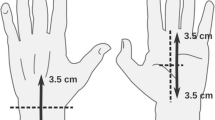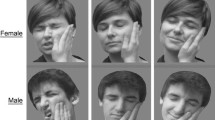Abstract
An experiment with 42 human Ss used the transswitching procedure to examine tonic stimulus control of phasic and tonic conditioned vasomotor heart rate, and electrodermal reactions. The conditional stimulus (CSs) were photos of angry and friendly human faces, and the unconditional stimulus (US) was a human scream. In one tonic context (blue light), the CSs were paired with the US, in the other context (yellow light), the CSs were presented unpaired. Following acquisition, an extinction series was run with the US omitted during both tonic contexts. Phasic vasomotor and skin conductance reactions differed in the positive and negative tonic segments (stronger in positive). The skin conductance responses also differed during extinction, but the vasomotor responses did not. Tonic differences (following onset of the tonic stimuli) in unelicited skin conductance response frequency, finger pulse volume, and heart rate were also found, although these developed more slowly than the phasic differences. The finger pulse volume tonic difference was greater in extinction than the skin conductance response frequency. There was no effect of the angry-friendly facial expressions, either directly or in interaction with the transswitching effects. The results were interpreted to mean that the transswitching phenomenon is not limited to one another autonomic effector, but is more generalized across the ANS (sympathetic branch). The absence of influence of the facial expressions indicates the relative weakness of the “preparedness” hypothesis in comparison with more influential contextual factors.
Similar content being viewed by others
References
Asratyan, E. A.Compensatory Adaptation, Reflex Activity, and the Brain (English translation: S. A. Corson). New York: Oxford University Press, 1965.
Cook, M. R. Psychophysiology of peripheral vascular changes. In P. A. Obrist, A. A. Black, J. Brener, and L. V. DiCara (Eds.),Cardiovascular Psychophysiology—Current Issues in Response Mechanisms, Biofeedback, and Methodology. Chicago: Aldine, 1974.
Ekman, P., Friesen, W., and Ellsworth, P.Emotion in the Human Face: Guidelines for Research and Integration of Findings. New York: Pergamon Press, 1972.
Fahrenberg, J., Selg, H., and Hampel, R.Das Freiburger Persöntichkeitsinventar. Göttingen: Hogrefe, 1973.
Fredrikson, M., and Öhman, A. Cardiovascular and electrodermal responses conditioned to fear-relevant stimuli.Psychophysiology, 1979,16, 1–7.
Furedy, J. J. Human orienting reaction as a function of electrodermal versus plethysmographic response modes and single versus alternating stimulus series.Journal of Experimental Psychology, 1968,77, 70–78.
Hamm, A., and Sturm, H.Elektrodermale und vasomotorische Reaktionen auf potentiell phobische versus nicht phobische Reize—Ein differentielles Konditionierungsexperiment. Diplomarbeit, Fachbereich Psychologie, Universität Giessen, 1981.
Kimmel, H. D., and Ray, R. L. Transswitching: Conditioning with tonic and phasic stimuli.Journal of Experimental Psychology: General, 1978,107, 187–205.
Kimmel, H. D., and Gardner, K. A. Transswitching as a means of studying within-subjects conditioning effects.Bulletin of the Psychonomic Society, 1981,6, 315–317.
Kimmel, H. D., Birbaumer, N., Elbert, T., Lutzenberger, W., and Rockstroh, B. Conditional tonic stimulus control of nonspecific arousal.The Pavlovian Journal of Biological Science, 1983,3, 136–143.
Konorski, K. O. Zmiennosci ruchowych reakcyi warunkowych—Zasady przeaczania korowego (The variability of conditioned motor reactions—The principles of cortical switching).Przeglad Fizjolcgii, Ruchu, 1939,9, 191–124.
Lindberg, L., and Wallin, B. G. Sympathetic skin nerve discharges in relation to amplitude of skin resistance responses.Psychophysiology, 1981,18, 268–271.
Öhman, A., and Dimberg U. Facial expressions as conditioned stimuli for electrodermal responses: A case of ‘preparedness’ ?Journal of Personality and Social Psychology, 1978,36, 1251–1258.
Prokasy, W. F., and Kumpfer, K. L. Classical conditioning. In W. F. Prokasy and D. C. Raskin (Eds.),Electrodermal Activity in Psychological Research. New York: Academic Press, 1973.
Author information
Authors and Affiliations
Additional information
This research was supported by research grant (VA 37/11) from the Deutsche Forschungsgemeinschaft (German Research Society) to Dieter Vaitl, Professor of Psychology, University of Giessen, FRG.
Rights and permissions
About this article
Cite this article
Vaitl, D., Gruppe, H. & Kimmel, H.D. Contextual stimulus control of conditional vasomotor and electrodermal reactions to angry and friendly faces. Pav. J. Biol. Sci. 20, 124–131 (1985). https://doi.org/10.1007/BF03003595
Issue Date:
DOI: https://doi.org/10.1007/BF03003595




